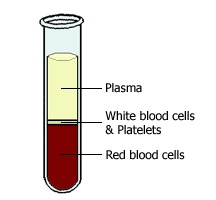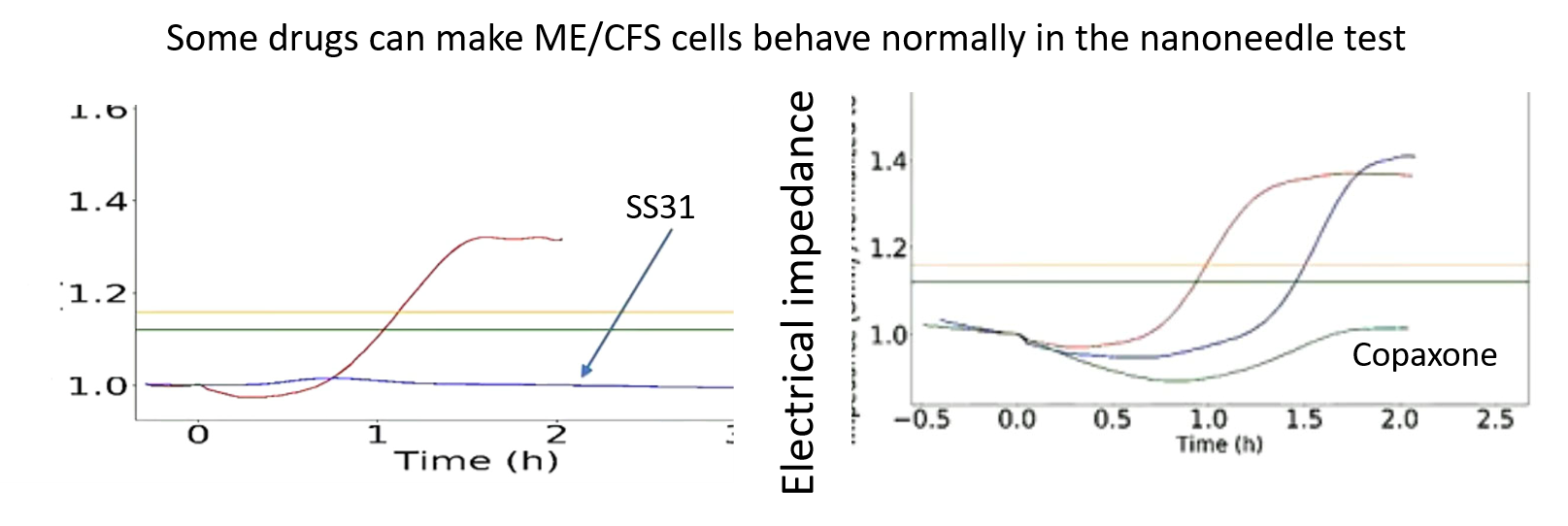By David Tuller, DrPH
Simon McGrath provides excellent accounts of research topics at his blog, ME/CFS Research Review. He is skilled at rendering complicated stuff into easy-to-understand prose. On December 10th, Simon posted this update of developments discussed by Stanford geneticist Ron Davis during a recent talk at the Albert Einstein College of Medicine in New York.
In his talk, Davis discussed the latest on the notion that “something in the blood” is playing a key role in the disease–a topic being explored by a number of research teams in addition to his. With Simon’s permission, I am re-posting his overview of the discussion. Since I am incapable of advanced technological maneuvers, I was delighted to find out that I could just copy Simon’s blog and paste it in here, and the graphics would reproduce here as they appeared there. Whew!
Latest from Ron Davis: more evidence of “something in the blood”
Dr Ron Davis recently revealed more evidence supporting the idea that there could be “something in the blood” that drives ME/CFS.
He’s been on a tour of the US East Coast, winning over scientists and clinicians, one lecture hall at a time.
Open Medicine Foundation has made available his talk at the Albert Einstein Medical Centre is now available. Much of the talk’s content will be familiar to ME/CFS patients. I am highlighting here the things that appeared to be new and particularly interesting.
Something in the (blood) plasma
Previous work from Ron Davis and others has suggested that an unknown factor in the blood is driving ME/CFS and can cause healthy cells to behave like ME/CFS cells.

Davis had already reported striking nanoneedle results. The nanoneedle measures electrical changes in a sample of simplified blood (effectively just white blood cells in plasma).
What proved to be revelatory in ME/CFS was the nanoneedle salt stress test. This simply involves adding some sodium chloride (table salt), which forces cells to use energy (sodium enters the cell and is a little toxic to them, so they must use energy to pump it out again).
When salt is added to a sample of healthy control cells not much happens electrically. But when salt is added to an ME/CFS sample, electrical impedance shoots up, as the graph below shows. It does this for every patient tested (an initial sample of 20, then 26 more), and doesn’t do this for every control tested to date.

Previously, he’d said that white blood cells taken from ME/CFS patients behave like normal, healthy cells if they are tested in plasma from healthy patients. Here, he presented data from one patient showing exactly that.

As in the previous graph, impedance shoots up for ME/CFS in their own plasma, while nothing much happens for healthy cells in their own plasma (patchy yellow line – sorry, a poor quality screenshot of video). But when ME/CFS cells are tested in plasma from healthy patients (green line, indicated by the arrow), the ME/CFS cells now behave much like healthy cells
So, something in (or missing from) the plasma seems to be affecting cells, making ME/CFS cells act abnormally. And finding the something responsible for that could provide a big clue to understanding ME/CFS.
Davis has previously talked about his team’s work to home in on the presumed “factor” in the blood. They start by splitting the blood, physically or biochemically separating its components into separate fractions. Then, they test to see which fraction of the blood contains the mystery factor. The next step is to split the “active” fraction into still further fractions, and so on.
Nanoneedle logjam
This work is being held up because the existing nanoneedle set-up is very slow. Davis’s team have had problems making the nanoneedle chips that take the blood samples. And the machine that processes the chips can only process two samples at a time.
The team have just built a prototype for a new machine that can process 200 samples simultaneously, which cost just $200 to build. And they now have more and better nanoneedle chips.
Davis said that these improvements will allow his team to get the nanoneedle programme “back on track’, including the work to find something in the blood.
Biology as well as biomarker
The nanoneedle has produced the most dramatic published results yet seen in ME/CFS, with clear blue water between patients and controls. The nanoneedle has real biomarker potential if the research pans out and the findings are specific to ME/CFS.
However, what excites me most is the possibility of uncovering the biology behind the nanoneedle result — perhaps “something in the blood” that could be playing a fundamental role in ME/CFS.
And there’s more
Previously, Davis had said that his team had been looking at something called red blood cell deformability. Red blood cells are uniquely flexible, which is essential as they have to squeeze (or deform) themselves through tiny capillaries to deliver their oxygen payload to tissues.
However, in some diseases, red blood cells (RBCs) lose some of their ability to deform.
Older research had indicated the same might be true for ME/CFS, but Davis had reported that his team’s promising, early, results didn’t hold up and this appeared to be a dead end. This work had been done with RBCs suspended in buffer (a fluid routinely used in lab work to keep cells stable). However, when they put the cells in patients’ own plasma instead, they started to see a significant difference between patients and controls.

These differences are not as dramatic as those seen with the nanoneedle, but it is another sign that something in the plasma of ME/CFS patients is causing cells to malfunction.
Other news: drug candidates and a pathogen hunt
Davis reported two other interesting findings.
In previous talks, he had said that the mitochondrial drug SS-31 completely normalised behaviour of patients’ cells in the nanoneedle (below, left). (This is encouraging but doesn’t necessarily mean it would help patients.) Now, they have found a similar effect for an MS drug, Copaxone, as well as less-impressive results for Suramin.

Still checking for ongoing infections
Work is continuing to identify – or rule out – the possibility of a microorganism causing ME/CFS.
A broad-brush approach of DNA sequencing DNA particles from the blood found no new or existing pathogens. This approach is being complemented by very sensitive methods. While these have found nothing yet, the work still has a long way to go.
So far, Davis’s team have found that ME/CFS patients have fewer DNA viruses than healthy controls. Testing for parasites and bacteria is ongoing. And they are planning a test to find any fungi in the blood.
That covers, I think, all the significant new announcements from Ron Davis. If I’ve missed anything, please let me know.
For me, the most important thing is that the idea of “something in the blood” remains alive and under active investigation.
Image credits: all graphs are screengrabs from the talk, labels edited by me for clarity.
Comments
3 responses to “Simon McGrath on Ron Davis on “something in the blood””
Whenever the results of a study show the exact same deviation for each and every participant from a heterogenous population, my gut as a scientist plays up. Questions like, were the samples of patients and control group obtained, kept and analyzed in the exact same manner and identical environment, tend to pop up.
Has there even been a single attempt to reproduce any of Davis’ findings? Everyone was so quick to attempt to disprove or confirm XMRV, why not now?
What we do know is that a serious commercial competition between this nanoneedle and other, similar devices is ongoing.
Did they check what happened with good white blood cells in ‘ME/CFS plasma’? If the ‘good’ cells then showed the increased ‘impedence’, that would confirm it really was something in the plasma (or missing from the plasma), and not something like a weakness in the ME/CFS cells and a deficiency of something in the ME/CFS plasma that exposes it, or a deficiency of some key component in the plasma that stops both good and ME/CFS cells working properly.
It seems there are more possible interpretations of the effect than covered by the combination of tests we are told of.
Here is a transcript of an interview with Ron Davis on this topic from earlier this year.
https://paradigmchange.me/wp/davis/